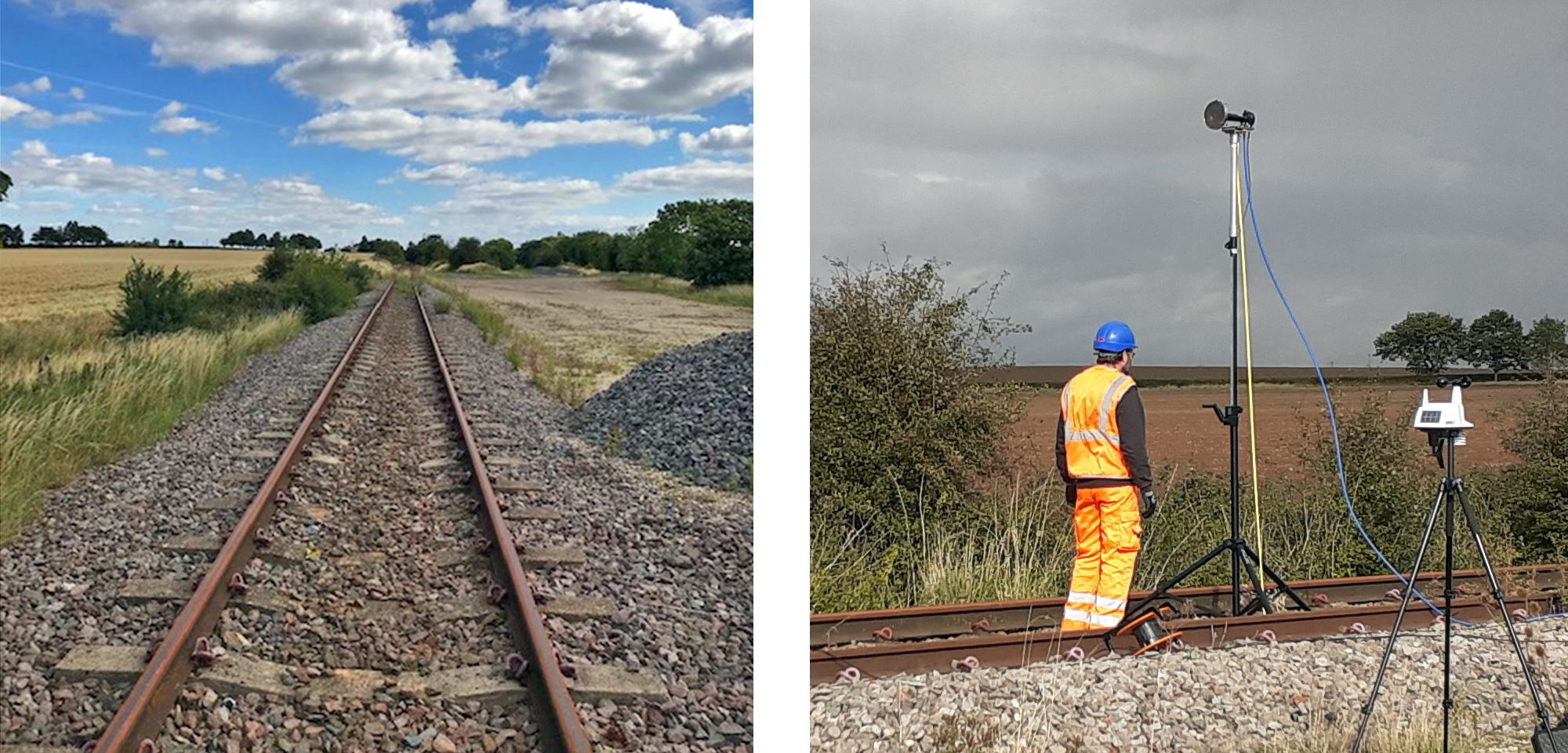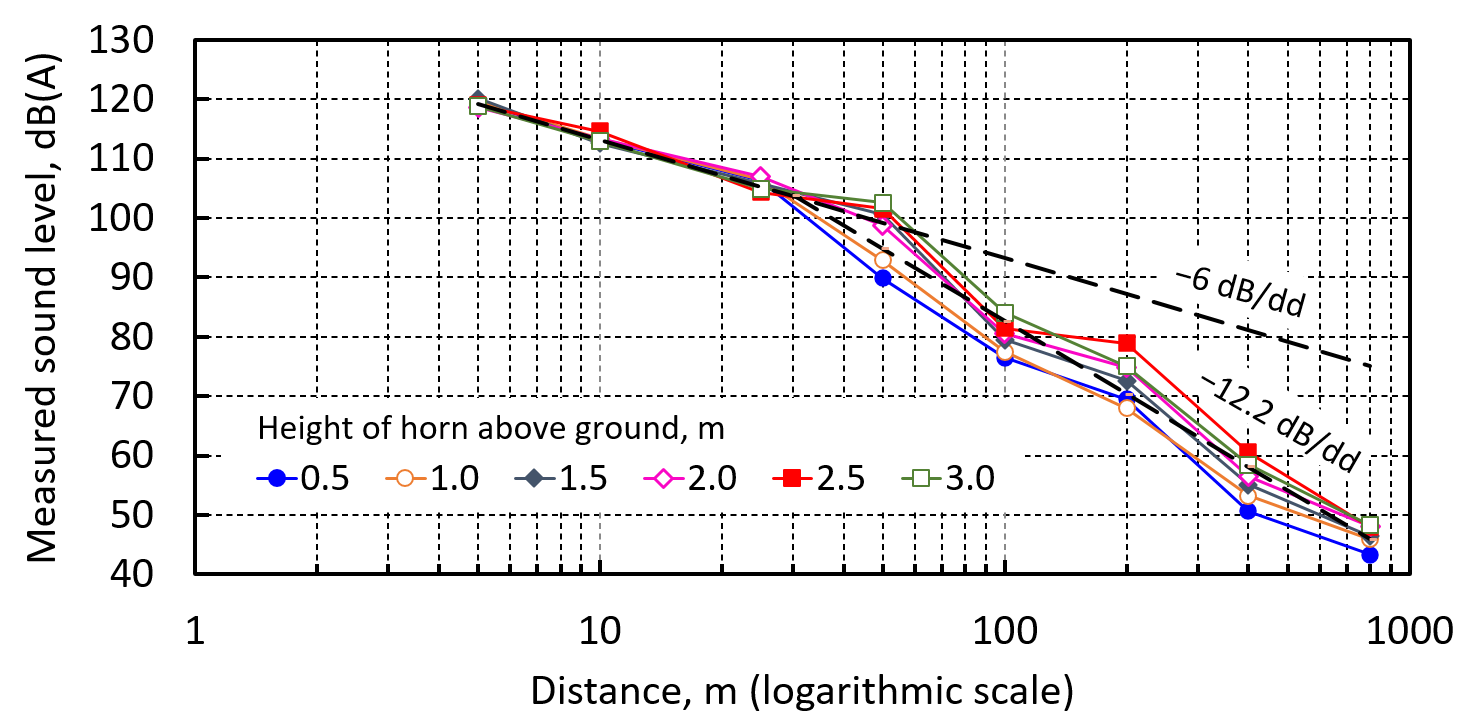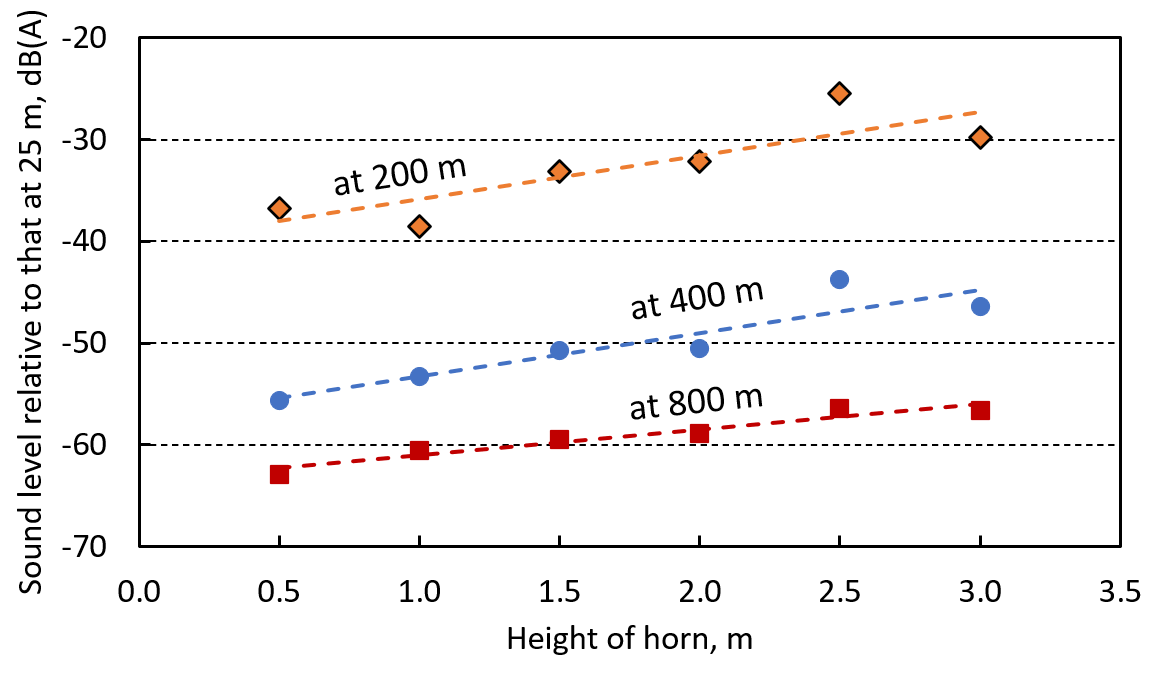Sound propagation and audibility of train horns
When track workers reported that the horns of some newer trains are quieter and less audible than horns of older trains, the Rail Safety and Standards Board (RSSB) commissioned ISVR Consulting to investigate. We studied the factors affecting the propagation of sound from train horns, and the horn sound levels of approaching trains as experienced in practice by track workers.
We carried out a literature search on the sound levels from horns, and measured sound levels and spectra from horns, first in an anechoic chamber, then with a stationary horn at a test track, and then at two sites on operational mainline railways.
Tests with a stationary horn
We measured the sound levels at 5, 10, 25, 50, 100, 200, 400 and 800 metres from a stationary horn at a railway test track near Tuxford. The microphones were 1.5 m above the track. The height of the horn was varied in 0.5 m steps from 0.5 m to 3.0 m above the ballast.

Left: View of the test track at Tuxford from the horn position. Right: The horn mounted on a tripod stand
These tests showed that sound levels from train horns decayed by 6 dB per doubling of distance (6 dB/dd), as expected, but only to about 30 m or 50 m from the train. Beyond 50 m for the high-mounted horn and beyond 30 m for a low-mounted horn, the sound decayed at approximately 12 dB per doubling of distance.

Sound levels at distances from 5 m to 800 m from the horn in static tests with the horn at different heights above the ballast. The key indicates the horn height from 0.5 m to 3.0 m
We also found that horns positioned 2.5 m to 3.0 m above the ground produced sound levels about 10 dB higher at 200 m and 400 m compared to horns 0.5 m above the ground, highlighting the importance of horn height for effective sound propagation. The effect of horn height does not show in the type-approval tests which only specify the minimum and maximum horn sound levels measured at 25 m from the train.

Sound levels from the horn at 200 m and 400 m were higher for a horn at 2.5 to 3 m above the track than for a horn close to the track
Tests on operational mainline railways
We carried out measurements at two rural sites. The first was on the Great Western Mainline and the second on the South West Mainline. We measured on two separate occasions at the first site. Each measurement site was down track from a ‘whistle board’, where the horn must be sounded.

The test sites on the Great Western Mainline (left) and South West Mainline (right)
We measured horn sound levels and ambient noise levels with two or three microphones placed at various distances along the track ahead of the trains. The horn sound levels from the Class 444/450 trains at the second site were very consistent from train to train, whereas the horn levels from the relatively new Class 80X trains at the first site showed some variation from train to train.
As well as the sound, the rail vibration was recorded using accelerometers and this, together with the wheel spacing of each train, enabled the train speeds to be accurately determined. The position of each train when the horn was sounded was calculated from the train speed, the speed of sound, and the time of arrival of the sound at the closest microphone. Because the position of each train was known when its horn was sounded, the sound attenuation rate could be calculated for individual horn blasts from the difference in sound levels between any two microphones each at a known, but different, distance from the train, ranging from 90 m to 450 m.
The attenuation rates of the sounds varied between 6.2 dB and 14.3 dB per doubling of distance at the two sites. As each attenuation rate was derived from measurements at two positions of the same horn, the measured attenuation rates do not depend on the absolute sound level output of each individual horn.

Horn sound attenuation rates beyond 90 m measured at the mainline sites
Audibility
We also enrolled panels of qualified and experienced track workers who were positioned at various distances along the test track in tests with the stationary horn, and at fixed positions ahead of the trains on the mainlines. We used Detectsound software and method (c) of International Standard ISO 7731 (BS EN ISO 7731) to calculate the minimum recommended sound levels for audibility based on the one-third octave band spectra of the ambient noise at the track workers’ positions. The track workers found the horn sound levels ‘clearly audible’ when the horn levels were at or above the minimum level recommended using either Detectsound or ISO 7731, with Detectsound being more consistent with the track workers’ ratings, but ISO 7731 being simpler. Horn sound levels were ‘clearly audible’ to the track workers when the A-weighted horn level was 7 dB above the A-weighted background noise. However, this finding is based on limited data and a simple signal-to-noise ratio may not be a good predictor of audibility at other sites, or with different background noise spectra.
Track workers also reported that newer trains have quieter horns than older ones. This can be partly attributed to lower minimum sound levels required in more recent standards and partly to the closer proximity of horns to the ground in newer trains.
Further details
This page is a brief overview of our study. For more detail on our methodologies, results, and conclusions see:
- Sound propagation and audibility of train horns. Martin Toward, Michael Lower, Marcus Wiseman, David Thompson and Paul Ferraby. Proceedings of Inter-noise 2022, 21-24 August 2022, Glasgow. (pdf 1077 kB)
- Relationship between train horn sound levels tested at 25 m and sound levels experienced at distance by track workers. (Accepted Manuscript), Martin Toward, Marcus Wiseman, Michael Lower and David Thompson. pp 141-148 in Noise and Vibration Mitigation for Rail Transportation Systems: 14th International Workshop on Railway Noise, 7-9 Dec 2022, Shanghai, China. Springer, Singapore. DOI: 10.1007/978-981-99-7852-6_12 (pdf 1.18 MB ↗)
This study was funded by the RSSB. Trent Instruments of Nottingham provided the horn used in the stationary tests.

